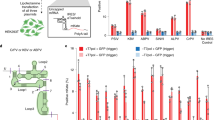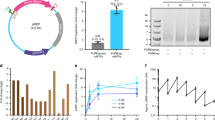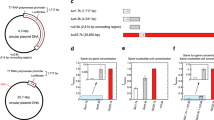Abstract
We present a temperature-regulated, alphavirus replicon-based DNA expression system. The system is regulated by a viral temperature-sensitive RNA-dependent RNA replicase, creating a temperature-dependent RNA amplification loop. Because of this positive feedback, the system exhibits both low background and high inducibility. We observed 700-fold induction in transiently transfected cells, and over 104-fold induction in stably transfected cells. The high stringency of inducibility allowed the generation of stable cell lines expressing a highly toxic protein upon temperature shift. These data suggest that the present expression system could simplify bioprocess engineering strategies, especially in situations where the cloned protein has detrimental effects on host cell metabolism.
This is a preview of subscription content, access via your institution
Access options
Subscribe to this journal
Receive 12 print issues and online access
$209.00 per year
only $17.42 per issue
Buy this article
- Purchase on Springer Link
- Instant access to full article PDF
Prices may be subject to local taxes which are calculated during checkout





Similar content being viewed by others
References
Cregg, J.M., Vedvick, T.S. & Raschke, W.C. Recent advances in the expression of foreign genes in Pichia pastoris. Biotechnology 11, 905–910 (1993).
Makrides, S.C. Strategies for achieving high-level expression of genes in Escherichia coli. Microbiol. Rev. 60, 512–538 (1996).
Umãna, P., Jean-Mariet, J., Amstutz, H., Moudry, R. & Bailey, J.E. Engineered glycoforms of an anti-neuroblastoma IgG1 with optimized antibody-dependent cellular cytotoxic activity. Nat. Biotechnol. 17, 176–180 (1999).
Fussenegger, M., Schlatter, S., Datwijler, D., Mazur, X. & Bailey, J.E. Controlled proliferation by multigene metabolic engineering enhances the productivity of Chinese hamster ovary cells. Nat. Biotechnol. 16, 468–472 (1998).
Saez, E., No, D., West, A. & Evans, R.M. Inducible gene expression in mammalian cells and transgenic mice. Curr. Opin. Biotechnol. 8, 608–616 (1997).
Gossen, M. & Bujard, H. Tight control of gene expression in mammalian cells by tetracycline-response promoters. Proc. Natl. Acad. Sci USA 89, 5547–5551 (1992).
Mangelsdorf, D.J. et al. The nuclear receptor superfamily: the second decade. Cell 83, 835–839 (1995).
No, D., Yao, T. & Evans, R.M. Ecdysone-inducible gene expression in mammalian cells and transgenic mice. Proc. Natl. Acad. Sci USA 93, 3346–3351 (1996).
Rossi, F.M.V. & Blau, H.M. Recent advances in inducible gene expression systems. Curr. Opin. Biotechnol. 9, 451–456 (1998).
Xiong, C. et al. Sindbis virus: an efficient, broad host range vector for gene expression in animal cells. Science 243, 1188–1191 (1989).
Schlesinger, S. Alphavirus vectors for the expression of heterologous genes. Trends Biotechnol. 11, 18–22 (1993).
Liljeström, P. & Garoff, H. A new generation of animal cell expression vectorsbased on the Semliki Forest virus replicon. Bio/Technology 9, 1356–1361 (1991).
Liljeström, P. Alphavirus expression systems. Curr. Opin. Biotechnol. 5, 495–500 (1994).
Strauss, J.H. & Strauss, E.G. The alphaviruses: gene expression, replication and evolution. Microbiol. Rev. 58, 491–562 (1994).
Herweijer et al. A plasmid-based self-amplifying Sindbis virus vector. Hum. Gene Ther. 6, 1495–1501 (1995).
Dubensky, T.W. et al. Sindbis virus DNA-based expression vectors: utility for in vitro and in vivo gene transfer. J. Virol. 70, 508–519 (1996).
Berglund, P., Tubelekas, I. & Liljeström, P. Alphaviruses as vectors for gene delivery. Trends Biotechnol. 14, 130–134 (1996).
Dryga, S.A., Dryga, O.A. & Schlesinger, S. Identification of mutations in a Sindbis virus variant able to establish persistent infection in BHK cells: the importance of a mutation in the nsP2 gene. Virology 228, 74–83 (1997).
Agapov, E.V. et al. Non-cytopathic Sindbis virus RNA vectors for heterologous gene expression. Proc. Natl. Acad. Sci. USA 95, 12989–12994 (1998).
Hahn, Y.S., Grakoui, A., Rice, C.M., Strauss, E.G. & Strauss, J.H. Mapping of RNA temperature-sensitive mutants of Sindbis virus: complementation group F mutants have lesions in nsP4. J. Virol. 63, 1194–1202 (1989).
Frolov, I. & Schlesinger, S. Translation of Sindbis virus mRNA: effects of sequences downstream of the initiating codon. J. Virol. 68, 8111–8117 (1994).
Sjöberg, E.M., Suomalainen, M. & Garoff, H. A significant improved Semliki Forest virus expression system based on translation enhancer segments from the viral capsid gene. Bio/Technology 12, 1127–1131 (1994).
Stanger, B.Z., Leder, P., Lee, T.H., Kim, E., & Seed, B. RIP: a novel protein containing a death domain that interacts with Fas/APO-1 (CD95) in yeast and causes cell death. Cell 81, 513–523 (1995).
Bredenbeek, P.J ., Frolov, I., Rice, C.M. & Schlesinger, S. Sindbis virus expression vectors: packaging of RNA replicons by using defective helper RNAs. J. Virol. 67, 6439–6446 (1993).
Jordan, M., Schallhorn, A. & Wurm, F.M. Transfecting mammalian cells: optimization of critical parameters affecting calcium-phosphate precipitate formation. Nucleic Acid Res. 24, 596–601 (1996).
Berger, J., Hauber, J., Hauber, R., Geiger, R. & Cullen, B.R. Secreted placental alkaline phosphatases: a powerful new quantitative indicator of gene expression in eukaryotic cells. Gene 66, 1–10 (1988).
Acknowledgements
We thank Prof. Sondra Schlesinger, Washington University (St. Louis, MO), for many helpful discussions and for providing the plasmids, p987BBneo and p987SinRep96. We acknowledge Dr. W.P.C. Stemmer, Maxygen (Redwood City, CA) for the GFP gene, Dr. P. Vito, Basel Institute for Immunology) for the RipDD gene, and we thank Drs. F. Hennecke, W. Hazenberg, and G. Orberger for helpful discussions.
Author information
Authors and Affiliations
Corresponding author
Rights and permissions
About this article
Cite this article
Boorsma, M., Nieba, L., Koller, D. et al. A temperature-regulated replicon-based DNA expression system. Nat Biotechnol 18, 429–432 (2000). https://doi.org/10.1038/74493
Received:
Accepted:
Issue Date:
DOI: https://doi.org/10.1038/74493
This article is cited by
-
Designed cell consortia as fragrance-programmable analog-to-digital converters
Nature Chemical Biology (2017)
-
A quick and efficient method to generate mammalian stable cell lines based on a novel inducible alphavirus DNA/RNA layered system
Cellular and Molecular Life Sciences (2014)
-
Synthetic biology: applications come of age
Nature Reviews Genetics (2010)
-
Adeno-associated viral vectors engineered for macrolide-adjustable transgene expression In mammalian cells and mice
BMC Biotechnology (2007)



